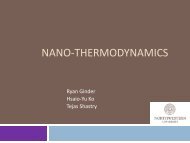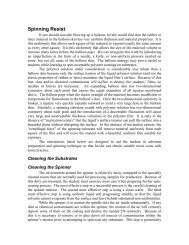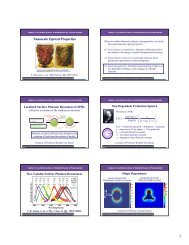A Practical Guide to SPM
A Practical Guide to SPM
A Practical Guide to SPM
Create successful ePaper yourself
Turn your PDF publications into a flip-book with our unique Google optimized e-Paper software.
13<br />
Figure 5-3 shows simultaneously acquired <strong>to</strong>pography and phase<br />
AFM images of a silicone hydrogel in saline solution. The four outer<br />
areas were exposed <strong>to</strong> a sequence of chemical processing steps. The<br />
central cross-like region, which was masked and thus protected from<br />
the processing, retained its hydrophobicity.<br />
Figure 5-3. Simultaneously acquired <strong>to</strong>pography (left) and phase<br />
(right) AFM images of a silicone hydrogel in saline solution.<br />
Field of view: 50µm.<br />
In the phase image (Figure 5-4), a marked phase shift is seen across<br />
the boundaries. The phase image is clearly providing material<br />
property contrast on this well-defined experimental hydrogel surface.<br />
The phase signal is sensitive <strong>to</strong> both short- and long-range tip-sample<br />
interactions. Short-range interactions include adhesive forces and<br />
frictional forces; long-range interactions include electric fields and<br />
magnetic fields.<br />
Phase detection is a key element in numerous scanning probe<br />
microscopy techniques, including magnetic force microscopy (MFM),<br />
electric force microscopy (EFM), and scanning capacitance<br />
microscopy (SCM).<br />
Magnetic Force Microscopy<br />
Magnetic force microscopy (MFM) is a secondary imaging mode<br />
derived from TappingMode that maps magnetic force gradient above<br />
the sample surface. This mapping is performed via a patented twopass<br />
technique, LiftMode. LiftMode separately measures <strong>to</strong>pography<br />
and another selected property (magnetic force, electric force, etc.)<br />
using the <strong>to</strong>pographical information <strong>to</strong> track the probe tip at a constant<br />
height above the sample surface during the second pass.<br />
Figure 5-4. Detail of Figure 5-3, showing boundary between<br />
hydrophilic and hydrophobic regions in <strong>to</strong>pography (<strong>to</strong>p) and<br />
phase (bot<strong>to</strong>m) images.<br />
The MFM probe tip is coated with a ferromagnetic thin film. While<br />
scanning, it is the magnetic field’s dependence on tip-sample<br />
separation that induces changes in the cantilever’s amplitude,<br />
resonance frequency, or phase (Figure 5-5). MFM can be used <strong>to</strong><br />
image both naturally occurring and deliberately written magnetic<br />
domains (Figure 5-6).<br />
MFM signal<br />
Magnetic<br />
domains<br />
Magnetic sample<br />
Figure 5-5. MFM maps<br />
the magnetic domains of<br />
the sample surface.<br />
Figure 5-6. MFM image<br />
showing the magnetic<br />
signature of data bits written<br />
on a hard disk, 3µm scan.
















